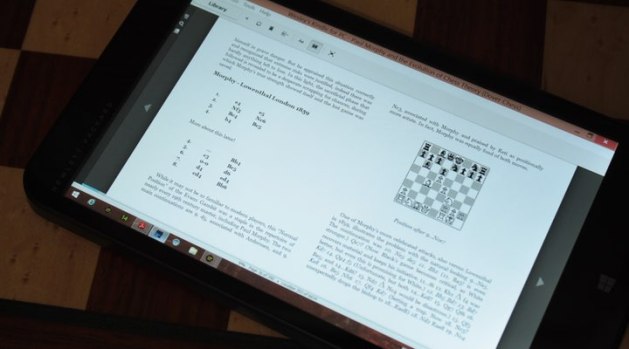Note: As of the date of this post, Amazon.com is offering a temporary discount for Amazon Prime customers on the entire line of Kindle e-readers. $30 off Kindle makes it $49.99, $30 off Kindle Paperwhite makes it $89.99, and $50 off Kindle Voyage makes it $149.99
Chess is a double-edged sword for book lovers. There are countless chess fanatics out there whose personal book collections rival some of the greatest libraries around the world and that assessment often does not include the assessment and inventory of digital materials storage on hard drives, USB flash drives, SD cards, and cloud servers. My personal collections straddles the line somewhere between print and digital with most of my collection belonging to the Kindle family of e-readers and Chessbase. As kind of a present to myself for completing my Masters Degree in March, I decided to finally retire my Kindle Paperwhite that has served me faithfully for many years and replace it with a Kindle Voyage, which is the most recent edition of Amazon’s e-reader.
The King of Electronic Books
It is hard to argue that Apple is the undisputed king of technology, Netflix is the king of streaming media, and Amazon.com is the king of digital books. The original Kindle device was high-priced, low memory, and low on production count. It sold out in record time and remained unavaialable due to inventory problems for months! Fast forward from 2007 to 2016 and the current edition of Amazon’s high-end Kindle is called the Kindle Voyage and it is much more than anyone could ever have expected in a digital book experience.

Kindle Voyage showing a Capablanca game (Credit: Campfire Chess)
Kindle vs. Kindle Voyage: How Far We Have Come
The original Kindle sold on Amazon.com for $400 and came with a whopping 250MB of onboard storage capacity, but that capacity could be upgraded using an expandable SD-card slot. On a sidenote, László Polgár’s epic Chess: 5334 Problems, Combinations, and Games clocks in at a whopping 292MB in its Kindle edition, which would eat up around 97% of the storage capacity on the first edition.
In contrast, the Kindle Voyage comes with 4GB of onboard storage, which allows for László’s work to sit comfortably on the device without limiting the amount of other material that can be carried along with it. For chess players whose libraries grow almost daily, this is excellent because the increased storage space means more room for chess more chess books! Personally, I liked the almost nondescript design of the Kindle Paperwhite, which is one of the reasons that it stuck with me as a personal reading device for so long. However, the Kindle Voyage takes the engineering advancements of the Paperwhite to create a near-perfect reading experience.

Crisp, high-definition e-ink display. (Credit: Campfire Chess)
As you can see from the screenshot above, the text is incredibly crisp and has a much clearer contrast than the Paperwhite. In addition to the traditional touchscreen controls introduced in the Kindle Touch, the device comes with buttons on each side of the screen for turning the page. Before the device arrived and I was able to start using it, these were one of the design features that made me nervous. However, these controls are something that have to be used to be appreciated. Although they are not buttons in the traditional sense, pressing on them creates a brief vibration in the device before turning the page. This haptic feedback sensation is unusual at first, but became comfortable very quickly and I think it is an excellent feat of engineering because it helps to reduce fingerprint buildup on the screen over time and also gives the user a real sense of control of the content as the book progresses.

I hope she’s reading Campfire Chess… (Credit: Amazon.com)
Although I highly recommend it, the Kindle Voyage is more of a luxury device tailored to avid readers or people who need a larger amount of storage space on their Kindle. For chess readers, it is a perfect device because the crisp display, long battery life, and large storage space combine to create a space to build an extensive portable chess library without having to lug a laptop around or depend on the limited battery life of an iPad, iPhone, or other tablet device. The Kindle Voyage currently runs for $199 on Amazon.com, although recent discounts and promotions seem to indicate that the Kindle line is mere days away from being refreshed.
Additional Reading:



 Chess and murder: do they go hand-in-hand? Hollywood has produced several films in which chess plays the central role in a murder mystery. Books of the same type or a little harder to come by. That is why I was excited when I came across Even Dead Men Play Chess by Michael Weitz. Caution, there are spoilers ahead!
Chess and murder: do they go hand-in-hand? Hollywood has produced several films in which chess plays the central role in a murder mystery. Books of the same type or a little harder to come by. That is why I was excited when I came across Even Dead Men Play Chess by Michael Weitz. Caution, there are spoilers ahead!









































